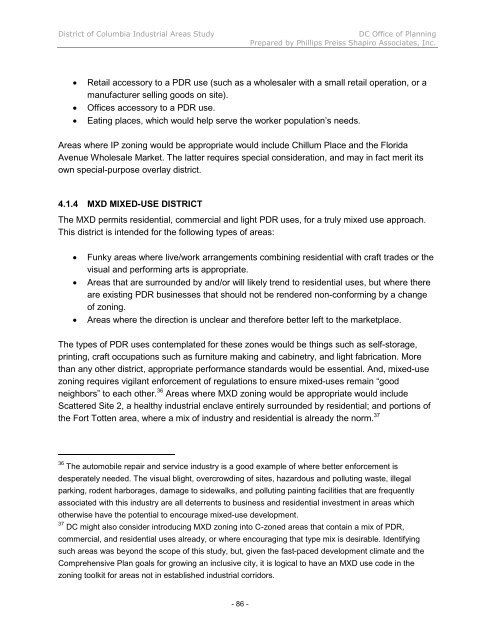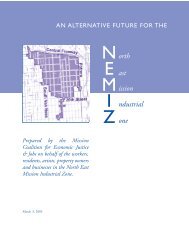INDUSTRIAL LAND IN A POST-INDUSTRIAL CITY District of ...
INDUSTRIAL LAND IN A POST-INDUSTRIAL CITY District of ...
INDUSTRIAL LAND IN A POST-INDUSTRIAL CITY District of ...
Create successful ePaper yourself
Turn your PDF publications into a flip-book with our unique Google optimized e-Paper software.
<strong>District</strong> <strong>of</strong> Columbia Industrial Areas Study DC Office <strong>of</strong> Planning<br />
Prepared by Phillips Preiss Shapiro Associates, Inc.<br />
Retail accessory to a PDR use (such as a wholesaler with a small retail operation, or a<br />
manufacturer selling goods on site).<br />
Offices accessory to a PDR use.<br />
Eating places, which would help serve the worker population’s needs.<br />
Areas where IP zoning would be appropriate would include Chillum Place and the Florida<br />
Avenue Wholesale Market. The latter requires special consideration, and may in fact merit its<br />
own special-purpose overlay district.<br />
4.1.4 MXD MIXED-USE DISTRICT<br />
The MXD permits residential, commercial and light PDR uses, for a truly mixed use approach.<br />
This district is intended for the following types <strong>of</strong> areas:<br />
Funky areas where live/work arrangements combining residential with craft trades or the<br />
visual and performing arts is appropriate.<br />
Areas that are surrounded by and/or will likely trend to residential uses, but where there<br />
are existing PDR businesses that should not be rendered non-conforming by a change<br />
<strong>of</strong> zoning.<br />
Areas where the direction is unclear and therefore better left to the marketplace.<br />
The types <strong>of</strong> PDR uses contemplated for these zones would be things such as self-storage,<br />
printing, craft occupations such as furniture making and cabinetry, and light fabrication. More<br />
than any other district, appropriate performance standards would be essential. And, mixed-use<br />
zoning requires vigilant enforcement <strong>of</strong> regulations to ensure mixed-uses remain “good<br />
neighbors” to each other. 36 Areas where MXD zoning would be appropriate would include<br />
Scattered Site 2, a healthy industrial enclave entirely surrounded by residential; and portions <strong>of</strong><br />
the Fort Totten area, where a mix <strong>of</strong> industry and residential is already the norm. 37<br />
36 The automobile repair and service industry is a good example <strong>of</strong> where better enforcement is<br />
desperately needed. The visual blight, overcrowding <strong>of</strong> sites, hazardous and polluting waste, illegal<br />
parking, rodent harborages, damage to sidewalks, and polluting painting facilities that are frequently<br />
associated with this industry are all deterrents to business and residential investment in areas which<br />
otherwise have the potential to encourage mixed-use development.<br />
37 DC might also consider introducing MXD zoning into C-zoned areas that contain a mix <strong>of</strong> PDR,<br />
commercial, and residential uses already, or where encouraging that type mix is desirable. Identifying<br />
such areas was beyond the scope <strong>of</strong> this study, but, given the fast-paced development climate and the<br />
Comprehensive Plan goals for growing an inclusive city, it is logical to have an MXD use code in the<br />
zoning toolkit for areas not in established industrial corridors.<br />
- 86 -












